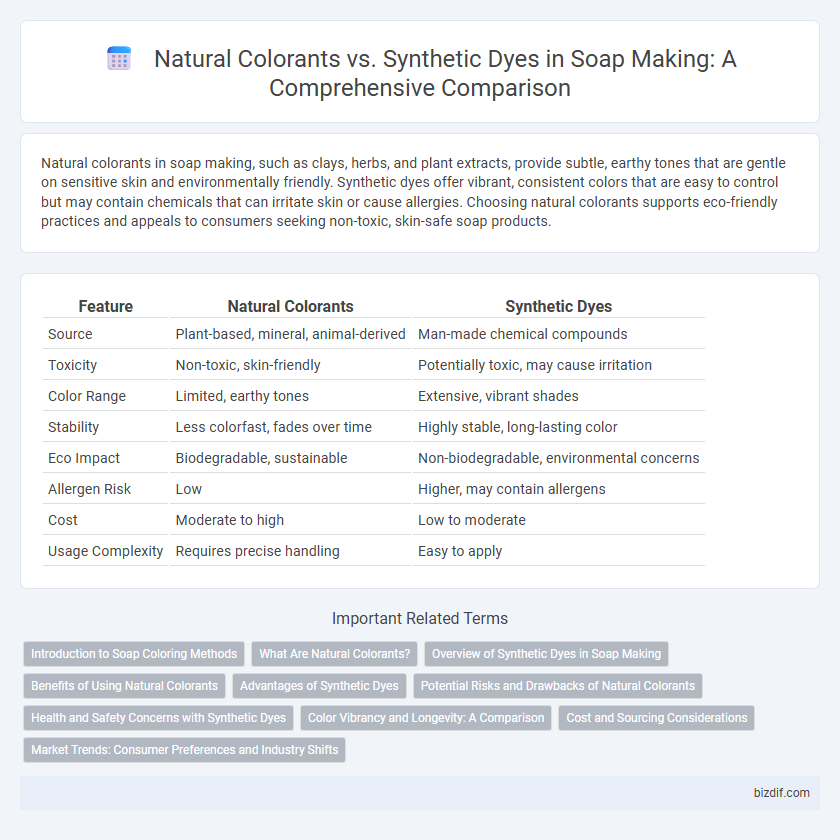Natural colorants in soap making, such as clays, herbs, and plant extracts, provide subtle, earthy tones that are gentle on sensitive skin and environmentally friendly. Synthetic dyes offer vibrant, consistent colors that are easy to control but may contain chemicals that can irritate skin or cause allergies. Choosing natural colorants supports eco-friendly practices and appeals to consumers seeking non-toxic, skin-safe soap products.
Table of Comparison
| Feature | Natural Colorants | Synthetic Dyes |
|---|---|---|
| Source | Plant-based, mineral, animal-derived | Man-made chemical compounds |
| Toxicity | Non-toxic, skin-friendly | Potentially toxic, may cause irritation |
| Color Range | Limited, earthy tones | Extensive, vibrant shades |
| Stability | Less colorfast, fades over time | Highly stable, long-lasting color |
| Eco Impact | Biodegradable, sustainable | Non-biodegradable, environmental concerns |
| Allergen Risk | Low | Higher, may contain allergens |
| Cost | Moderate to high | Low to moderate |
| Usage Complexity | Requires precise handling | Easy to apply |
Introduction to Soap Coloring Methods
Natural colorants in soap making, such as clays, herbs, and plant-based powders, provide subtle, earthy hues and are prized for their skin-friendly, chemical-free properties. Synthetic dyes, including FD&C and D&C colors, offer vibrant, consistent shades and a broader color palette but may contain chemicals that irritate sensitive skin. Choosing between these coloring methods depends on the desired aesthetic, skin safety considerations, and the soap recipe's compatibility with heat and pH levels.
What Are Natural Colorants?
Natural colorants in soap making are derived from plant-based sources such as herbs, spices, clays, and vegetable powders, offering eco-friendly and skin-safe alternatives to synthetic dyes. These colorants provide subtle, earthy hues that can vary depending on factors like pH and oil content in the soap mixture. Unlike synthetic dyes, natural colorants often contain antioxidants and beneficial compounds that enhance the soap's overall skin-nourishing properties.
Overview of Synthetic Dyes in Soap Making
Synthetic dyes in soap making offer vibrant, consistent colors that are resistant to fading and discoloration over time. These dyes are chemically formulated for high solubility in soap bases, ensuring even distribution without altering the soap's texture or properties. Their wide color range and stability make synthetic dyes a popular choice for commercial soap production seeking predictable and visually appealing results.
Benefits of Using Natural Colorants
Natural colorants in soap making provide eco-friendly and skin-safe alternatives to synthetic dyes, reducing exposure to harmful chemicals. Ingredients like turmeric, indigo, and spirulina offer vibrant hues while delivering added skin benefits such as anti-inflammatory and antioxidant properties. These naturally sourced pigments enhance soap quality by maintaining biodegradability and supporting sustainable production practices.
Advantages of Synthetic Dyes
Synthetic dyes in soap making offer vibrant, consistent colors that remain stable over time and resist fading. They provide a broad spectrum of hues that can be precisely controlled to achieve desired shades, enhancing product appeal. Their cost-effectiveness and high availability make synthetic dyes a practical choice for large-scale soap production.
Potential Risks and Drawbacks of Natural Colorants
Natural colorants in soap making, such as clays, botanical powders, and plant extracts, may pose potential risks including inconsistent color outcomes and faster fading due to light and pH sensitivity. Some natural pigments can also cause allergic reactions or skin irritation in sensitive individuals, highlighting the importance of patch testing. Furthermore, natural colorants often have limited shelf life and may require careful storage to prevent microbial contamination during soap production.
Health and Safety Concerns with Synthetic Dyes
Synthetic dyes in soap making often contain harmful chemicals that can cause skin irritation, allergies, and long-term health risks such as carcinogenic effects. Natural colorants derived from plant extracts, clays, and minerals provide safer alternatives, reducing the risk of toxic reactions and environmental damage. Awareness of the chemical composition and potential hazards of synthetic dyes is crucial for formulators prioritizing consumer safety and product integrity.
Color Vibrancy and Longevity: A Comparison
Natural colorants in soap making, such as clays, herbs, and spices, offer subtle, earthy hues that may fade over time due to exposure to light and air. Synthetic dyes, including FD&C and D&C colorants, provide vivid, consistent colors with high vibrancy and greater longevity, maintaining their appearance throughout the soap's lifecycle. The choice between natural and synthetic depends on the desired balance of aesthetic intensity and eco-friendly, skin-safe ingredients.
Cost and Sourcing Considerations
Natural colorants in soap making often incur higher costs due to limited availability and seasonal sourcing constraints, making them less predictable for large-scale production. Synthetic dyes offer more consistent pricing and ease of procurement through industrial suppliers, providing soap makers with budget-friendly and reliable options. However, natural colorants appeal to eco-conscious consumers despite their variable cost and sourcing challenges.
Market Trends: Consumer Preferences and Industry Shifts
Natural colorants in soap making like turmeric, indigo, and beetroot are gaining traction due to rising consumer demand for eco-friendly and skin-safe products. The global market shift reflects a preference for organic and biodegradable ingredients, as synthetic dyes face scrutiny for potential health risks and environmental impact. Industry reports indicate a consistent growth rate of over 8% annually in natural colorant adoption, signaling a major trend toward sustainable soap formulations.
Natural Colorants vs Synthetic Dyes Infographic

 bizdif.com
bizdif.com